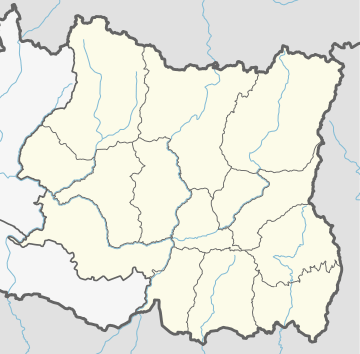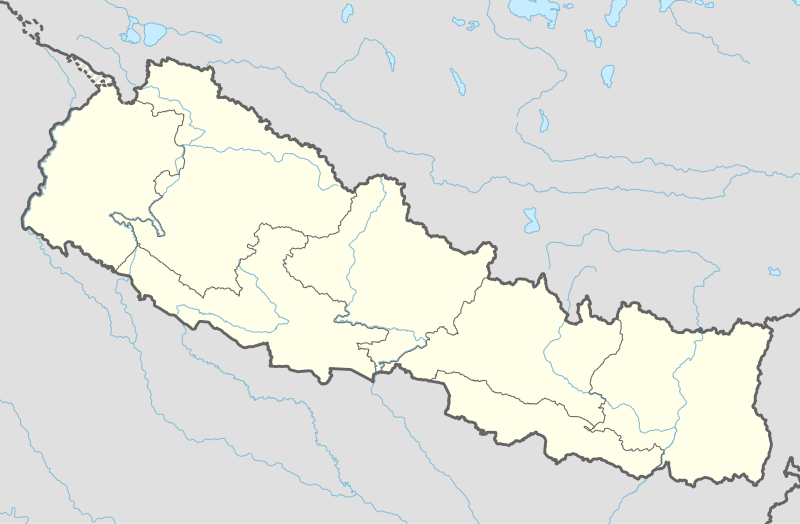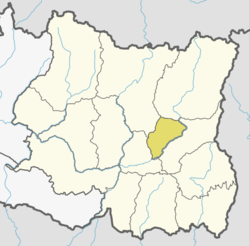Myanglung
Myanglung (Nepali: म्याङलुङ) is a municipality and the district headquarters of Terhathum District of Province No. 1 in eastern Nepal. The municipality is situated at an elevation of about 1500 metres above sea level.[1] Myanglung was converted into a municipality from a village development committee on 18 May 2014, merging the existing village development committees of Myanglung, Piple, Jirikhimti, Ambung, Sabla and Tamphula.[2][3] According to the census of 2011 the total population of Myanglung is 19,659 including five VDCs.[4]
Myanglung म्याङलुङ | |
|---|---|
 Myanglung Location in Province No. 1  Myanglung Myanglung (Nepal) | |
| Coordinates: 27°7′38″N 87°32′10″E | |
| Country | |
| Province | Province No. 1 |
| District | Tehrathum |
| No. of wards | 10 |
| Established | 18 May 2014 |
| Government | |
| • Type | Mayor–council |
| • Mayor | Mr. Sanjay Kumar Tumwahanfe (NCP) |
| • Deputy Mayor | Mrs. Parbati Sanu Dangi (NCP) |
| Area | |
| • Total | 100.21 km2 (38.69 sq mi) |
| Elevation | 1,500 m (4,900 ft) |
| Population (2011) | |
| • Total | 19,659 |
| • Density | 200/km2 (510/sq mi) |
| Time zone | UTC+5:45 (NST) |
| Website | official website |
People
A mixed variety of people live here.People here are friendly, hospitable. they are hard working and honest.
History
The Myanglung, along with the Tehrathum, were annexed into the unified Nepal by Prince Bahadur Shah in 1780s. Earlier it was a province of Pallo Kiraat. A story behind the naming of the place is popularly recited in the area. There was a chautari under a big tree (वरको रूख). Two porters who had stopped on the chautari were amazed when their cooking pot fell down from the fireplace after an unusual shaking. That made a "Myang lung" sound which they gave to the place as a good name. A temple is standing there that carries a history of the ancient chautari. In Limbu language, myang means cat and lung means stone. Myanglun was formed by the two Limbu language words.
Academic agencies
Singha Bahini Higher Secondary School and Saraswoti Secondary School are the community schools, whereas several other English medium boarding schools have been run by the private sector; such as Deepjyoti English Boarding School (first private school in Myanglung established 2044), Araniko English Boarding School and Annapurna English Boarding School. For higher education and terathum montessori for pre primary education. Myanglung campus situated at Myanglung Municipality and Terathum Campus (popularly known as Chuhandada Campus) situated at Chuhandanda are prominent academies in the area. The Tehrathum Campus, established in 2017 B.S., is one of the oldest campuses in Nepal.
There are no any media in Myanglung.
Commercial centres
For the economic activities of the entire district, governmental and non governmental banks such as Nepal Bank and some private banks such as Sunrise Bank Ltd, Nepal SBI Bank Ltd., Sanima Bank Ltd. and Global Bank Ltd. have sister banks in the area. The banks in the area have Automated teller machines.
Industrial area
A small cottage industry called Gharelu dhaka udyog produces textiles products which is an important industry in Myanglung. Other small industries such as Bakery, Bricks are exist.
Business
Agriculture is the main business of people outside Myanglung, whereas people within Myanglung have different kinds of businesses. As a whole, vegetable production and selling in the local market are regarded as the main businesses. Basically, surrounding area of Myanglung renown for the production/trade of black cardamom and ginger.The main foregin export is done in India by adua pakat office.
Haat is conducted twice a week on Friday and Tuesday, where local people buy vegetables and other things from vendors from the surrounding villages. People from the surrounding villages as well as various parts of the district visit to Myanglung for shopping and other activities.
Tourism
Myanglung attracts domestic and foreign tourists, and the town serves as a tourist hub.
A lake or pond called Chichi lung is situated at Deurali Dada, Teenjure Milke Gurase Hilltop, and is known as the capital of rhododendrons, Hyatrung Waterfall (हयातरूङ झरना) is the highest or longest waterfall in Nepal and the second highest in Asia,[5][6] and is situated in Ishibu. A tea garden situated at Solma, is a popular tourist attraction.
References
- Districts of Nepal, Statoids
- 72 new municipalities announced, My Republica
- Govt announces 72 new municipalities Archived 2014-10-06 at the Wayback Machine, The Kathmandu Post
- National Census 2011
- "Hyatrung Jharna (Nepali)". Tourism Office Kakarvitta.
- "Natural Landmarks". Retrieved March 2015. Check date values in:
|accessdate=(help)
